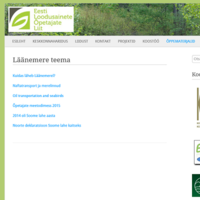Information
Information
The Baltic Sea Challenge (BSC) is an international network of organisations committed to Baltic Sea protection and implementing water protection activities. The common vision of the network is to achieve a clean, productive and shared Baltic Sea. The water protection activities of the network members are grouped under five objectives:
- Clear coastal waters
- Healthy marine habitat
- Clean and safe water traffic
- Systematic water area management
- Active Baltic Sea citizenship
The strength of the network is in its members
The Baltic Sea Challenge network has more than 270 members in the Baltic Sea region: municipalities, NGOs, companies, educational institutions, universities and regional organisations. Members join together within the network to share best practices, organise events and produce materials aimed at protecting the waters of the Baltic Sea region. Joint projects with external funding have also been launched within the network. The Baltic Sea Challenge network provides a range of benefits for its members: the expertise of the other network members, support and a framework for creating concrete water protection measures and a strong communications channel. The network is an informal, easy and direct cooperation tool for water protection. It enables members to learn new practices and builds bridges between different organisations and operational models – private and public, large and small, local and national. Network membership is free of charge. Core funding for the network is allocated by the cities of Turku and Helsinki in Finland.
From bilateral dialogue to network conversation
The Baltic Sea Challenge initiative for the protection of the sea was launched in 2007 by the mayors of the Finnish cities of Helsinki and Turku. These cities consider the state of their local waters and the Baltic Sea to form the basis of their competitiveness and have published a joint Baltic Sea Action Plan with around 40 activities that exceed the basic legal requirements in place. They have also challenged other organisations to join them in this task. In just the first year, over 100 organisations have joined the network – evidence of the pressing need to develop networking in order to enhance Baltic Sea protection work among organisations of different kinds. In the early mobilisation phase, collective network development was supported by the proactive measures and personal contacts of the mayors. The BSC network was founded by two cities that launched their joint action plan in full mutual cooperation – this helped to build trust within other organisations and demonstrated the openness and non-centralised nature of this particular network. New members are joining the Baltic Sea Challenge network on a monthly basis. Systematic development of the concept, activities and practices of the network is continuous. All of this has proven that the Baltic Sea Challenge has the systemic trust and social capital required for a successful and functional network. Helsinki and Turku updated their joint Baltic Sea Action Plan for 2014–2018 with 75 water protection activities and set out a new operating model including five priorities for the Baltic Sea Challenge network.
Bank of Actions
Bank of Actions
On the map below, you can find examples of water protection measures within this topic. These actions are picked from the Bank of Actions – if you are interested to browse other water protection actions, visit the Bank of Actions.
![]() Agriculture
Agriculture
![]() Awareness raising
Awareness raising
![]() Hazardous materials
Hazardous materials
![]() Littering etc.
Littering etc.
![]() Oil spill prevention
Oil spill prevention
![]() Research and monitoring
Research and monitoring
![]() Shipping and boating
Shipping and boating
![]() Stormwater management
Stormwater management
![]() Strategies and programs
Strategies and programs
![]() Wastewater management
Wastewater management
![]() Other
Other
![]() Drainage basin
Drainage basin
Guidelines & Recommendations
Guidelines & Recommendations
How to join the Baltic Sea Challenge?
- Discuss the Baltic Sea within your organisation. Would you like to commit to water protection?
- Brainstorm together about how you might improve the ecological condition of the waters through your own work. Take a look at the examples and tips that we have collected for you.
- If you need support, you can contact the coordinators of the Baltic Sea Challenge (see contact details here).
- Choose at least one action for protecting the waters that suits your operations and that your organisation can commit to launching within a year.
- Download the Baltic Sea Challenge commitment form from Extras, by choosing one of the language options on the right.
- Make sure that your organisation is ready to commit to the vision and objectives of the Baltic Sea Challenge. Inform your co-workers about the commitment.
- Fill in the Commitment Form and send it, together with your Baltic Sea Action Plan if you have one, to the coordinators of the Baltic Sea Challenge using the electronic form on the Baltic Sea Challenge website. You may also send the material to us via the post. (See contact details here.)

The Baltic Sea Challenge is an informal, easy and direct co-operation tool for water protection (Photos Jussi Karmala and Tina Nyfors)
How can we create an action plan?
Read instructions and tips here.
How can we update our commitment?
Read instructions and download the commitment form to be filled in here.
How can we share an action to be included in the Bank of Actions?
Fill in the electronic form here.
Extras
Extras
For further information, you are most welcome to visit the Baltic Sea Challenge web site!
Commitment forms
Useful reading
CITYWATER – Benchmarking water protection in cities. Layman’s report.
Link_to_the_report
Laine, K. 2015. Development plan of nature centre concept in Yyteri, Pori. Benefiting the Baltic Sea Challenge by a registered trademark. Satakunta University of Applied Sciences, Degree Programme in Innovative Business Services.
The purpose of the thesis was to find out by the means of a framework/ development plan, how municipalities and companies could find a way to protect the Baltic Sea together. The objective is to improve the state of the Baltic Sea through the cooperation of municipalities and companies. The key concepts of this thesis are the Baltic Sea, sustainable tourism and water protection.
Link to the thesis
Ritvala, T. & Salmi, A. 2009. Networking around a common issue – From words to action in the case of clean Baltic Sea. Helsinki School of Economics, International Business.
The paper investigates the early emergence of (collective) action around a common issue, i.e. the poor condition of the Baltic sea. The role of network mobilizers in promoting the issue and its solutions is considered, as well as the mobilization mechanisms that the key players are using. How can an actively and widely presented interest in the issue by very different types of actors be turned into concrete actions?
Link to the article
Ruokanen, L. & Lauttamäki, S.-M.. 2014. Baltic Sea Challenge – Networking and experience exchange enhancing the implementation of concrete water protection measures. Linnaeus ECO-TECH` 14, Kalmar, Sweden, November 24-26, 2014.
This article describes briefly the environmental problems of the Baltic Sea, local organizations’ role in tackling these problems and networking as an instrument to enhance local level implementation with the BSC as an example. The most important part is the compilation of evaluations on how the BSC network has succeeded in network mobilization, creating intrinsic trust among the members, how the BSC has succeeded in supporting its member organizations in water protection activities, and progress in the coordinating cities’ internal operations and the strategic level of considering water protection as a competitiveness issue.
Link to the article





